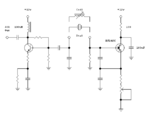neazoi
Advanced Member level 6

Hello I have built this HF oscillator (1-21MHz) and I monitor the output sitnal on the FFT and on a nearby ssb receiver.
I have a weird problem. When the circuit operates with a crystal, the tone on the ssb receiver is nice and smooth like it should be.
However, when the circuit operates on some inductors, the tone is "ringing". I do not know if it is amplitude variations that cause this or frequency variations.
On some coils (can transformers) the circuit does not "ring".
I power the circuit from a lab psu, regulated but not the cleanest one.
I have a weird problem. When the circuit operates with a crystal, the tone on the ssb receiver is nice and smooth like it should be.
However, when the circuit operates on some inductors, the tone is "ringing". I do not know if it is amplitude variations that cause this or frequency variations.
On some coils (can transformers) the circuit does not "ring".
I power the circuit from a lab psu, regulated but not the cleanest one.


